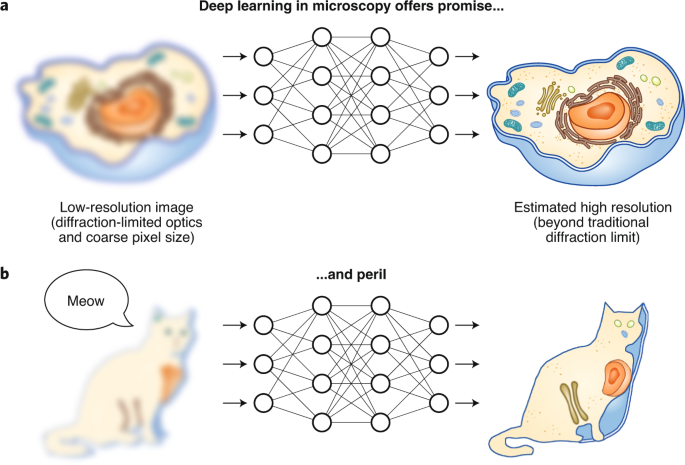
The promise and peril of deep learning in microscopy
- Select a language for the TTS:
- UK English Female
- UK English Male
- US English Female
- US English Male
- Australian Female
- Australian Male
- Language selected: (auto detect) - EN
Play all audios:

Access through your institution Buy or subscribe Ever since van Leeuwenhoek peered into his homemade microscope and revealed a world inhabited by “small animals,” scientists have been
pushing the limits of microscopy to see ever finer details in living cells and organisms. Though current methods would be science fiction to van Leeuwenhoek, we’ve entered an era of
diminishing returns: camera sensors are 95% efficient, modern lasers can evaporate samples, fluorescent molecules reliably emit thousands of photons, and objectives lenses hit their
fundamental physical performance limit over a century ago. Nevertheless, a “resolution revolution” seeded by Lukosz in the 1960s and heralded by Hell, Gustafsson and Betzig in the 2000s
introduced “super-resolution” (SR) to the scientific vernacular. In this issue of _Nature Methods_, Qiao et al.1 continue the revolution by riding the tidal wave of deep learning (DL) — a
framework rooted in the 1940s2 that has only recently enjoyed the computational muscle required by any but the simplest tasks3 — and present alchemic results: transforming low-resolution,
low-contrast, noisy images into super-resolved, high contrast, clean micrographs. Qiao et al.’s achievement is threefold. First, they collect an exceptional training dataset1, an invaluable
public resource for new method development, consisting of matched noisy, low-resolution images and high-quality, super-resolved, structured illumination microscopy (SIM, a variant of SR
microscopy) reconstructions. Second, they introduce two DL architectures, termed deep Fourier channel attention networks (DFCAN) and deep Fourier generative adversarial networks (DFGAN),
which, as their names imply, learn feature representations in the Fourier domain; and finally, they apply the networks to both the perennial problem of SIM reconstruction from nine
low-quality images and the more fantastical concept of single-image SR (SISR)4, in which an SR image is inferred entirely from a single diffraction-limited, or lower resolution, image. This
is a preview of subscription content, access via your institution ACCESS OPTIONS Access through your institution Access Nature and 54 other Nature Portfolio journals Get Nature+, our
best-value online-access subscription $29.99 / 30 days cancel any time Learn more Subscribe to this journal Receive 12 print issues and online access $259.00 per year only $21.58 per issue
Learn more Buy this article * Purchase on SpringerLink * Instant access to full article PDF Buy now Prices may be subject to local taxes which are calculated during checkout ADDITIONAL
ACCESS OPTIONS: * Log in * Learn about institutional subscriptions * Read our FAQs * Contact customer support REFERENCES * Qiao, C. _Nat. Methods_ https://doi.org/10.1038/s41592-020-01048-5
(2021). * McCulloch, W. S. & Pitts, W. _Bull. Math. Biophys._ 5, 115–133 (1943). Article Google Scholar * Silver, D. et al. _Nature_ 550, 354–359 (2017). Article CAS Google Scholar
* Dong, C., Loy, C. C., He, K. & Tang, X. _IEEE Trans. Pattern Anal. Mach. Intell._ 38, 295–307 (2016). Article Google Scholar * McElreath, R. _Statistical Rethinking: A Bayesian
Course with Examples in R and Stan_ (Taylor and Francis, 2020). * Citron, D. Deep fakes: a looming challenge for privacy, democracy, and national security. _Center for Internet and Society_
https://cyberlaw.stanford.edu/publications/deep-fakes-looming-challenge-privacy-democracy-and-national-security (2018). * Wang, H. & Yeung, D.-Y. A survey on Bayesian deep learning. _ACM
Comput. Surv._ 53, 1–37 (2020). Google Scholar * Eisenstein, M. _Nat. Methods_ 17, 1075–1079 (2020). Article CAS Google Scholar * Hutson, M. _Science_
https://doi.org/10.1126/science.aau0577 (2018). * D’Amour, A. et al. Underspecification presents challenges for credibility in modern machine learning. Preprint at _arXiv_
https://arxiv.org/abs/2011.03395 (2020). Download references AUTHOR INFORMATION AUTHORS AND AFFILIATIONS * 10x Genomics, Pleasanton, CA, USA David P. Hoffman * DrivenData Inc, Denver, CO,
USA Isaac Slavitt & Casey A. Fitzpatrick Authors * David P. Hoffman View author publications You can also search for this author inPubMed Google Scholar * Isaac Slavitt View author
publications You can also search for this author inPubMed Google Scholar * Casey A. Fitzpatrick View author publications You can also search for this author inPubMed Google Scholar
CORRESPONDING AUTHOR Correspondence to David P. Hoffman. ETHICS DECLARATIONS COMPETING INTERESTS The authors declare no competing interests. RIGHTS AND PERMISSIONS Reprints and permissions
ABOUT THIS ARTICLE CITE THIS ARTICLE Hoffman, D.P., Slavitt, I. & Fitzpatrick, C.A. The promise and peril of deep learning in microscopy. _Nat Methods_ 18, 131–132 (2021).
https://doi.org/10.1038/s41592-020-01035-w Download citation * Published: 21 January 2021 * Issue Date: February 2021 * DOI: https://doi.org/10.1038/s41592-020-01035-w SHARE THIS ARTICLE
Anyone you share the following link with will be able to read this content: Get shareable link Sorry, a shareable link is not currently available for this article. Copy to clipboard Provided
by the Springer Nature SharedIt content-sharing initiative
